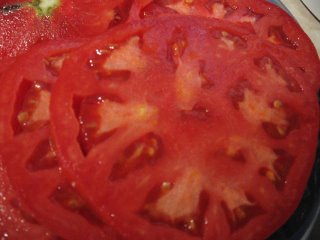 Beefmaster Tomatoes
Beefmaster TomatoesBeefmasters are a beefsteak tomato that has performed well for me this year. The only thing I did differently when growing tomatoes this year was to increase the amount of epsom salt used. The plants have rewarded me with about as close to perfect tomatoes as you could get especially when I garden organically. Now these tomatoes are beautiful sandwich tomatoes. They are full and meaty with a wonderful aroma and full bodied flavour with an impressive depth. Each one is weighing in at just under a pound but there is one on the vine that I think will surpass the pound mark. It is a real beauty!
 Beefamster Slice
Beefamster SliceOne slice of the Beefmaster is enough for a sandwich! My husband is elated and is guarding the tomatoes with a passion. We leave them on the vine until ripe for picking if at all possible. The tomato is then picked within minutes of making sandwiches for the best flavour.
A note on flavour of tomatoes. I have 32 plants growing outside along with more in the greenhouse and I intend to try growing indoors this winter. A charitable organization asked if I could donate some slicing tomatoes for an event they were having. I was honoured to be asked and gladly dropped them off. Imagine my horor when the person who took the tomatoes said she would put them in the fridge. I just about fainted! The thought of my tomatoes going into a fridge was absolutely horrid. I calmly explained why tomatoes should never be refrigerated and believe me I was almost ready to take back my donation just to protect the tomatoes then return them the day of the event. Honestly, tomatoes should never be refrigerated. They lose flavour and texture turning mealy. That is just not good. Use as close to picking as possible and leave at room temperature for storage. Aside of that process them into any number of tomato products the same day they are picked.
 Flavoured Vinegars
Flavoured VinegarsOne of my raised garden beds is dedicated to growing herbs so I have about 40 different herbs. That presents the problem of preserving them. One way is to make flavoured vinegars. I insist on good vinegars and a wide variety so last count I think I had something like 25 and vinegar of some type is used on a regular basis daily. Different vinegars are used for different purposes. Some vinegars can be boiled down to make a sweet sauce that is so much different than the actual vinegar. These are just a few of my homemade flavoured vinegars.
Back Row: raspberry vinegar, lemon thyme/lemon balm vinegar, basil/chives vinegar
Front Row: rosemary/lavender vinegar, purple basil/oregano/lemon thyme vinegar
The trick is finding a combination you like and to not sticking to using plain white vinegar as a base. Experiment with the base vinegar. Aged white wine vinegar makes a lovely base. In general, use a strong base with storng flavoured herbs and a delicate base with milder herbs.
My Method: The first step is of course cutting the herbs then deciding what vinegar base I'm going to use. The herbs are washed then ingredients assembled. The bottles are generally recycled bottles that are sterilized including the caps or corks. I use 3 - 4 sprigs of herbs per 2 cups of vinegar and I'm not scared to mix and match herbs because sometimes the combination just works well. I usually have an idea as to what I want and what the vinegar will be used for. Some vinegars I make are designed for one specific purpose. The sprigs are placed in the bottle then the base vinegar is then heated to just below the boiling point and poured in. The bottle is capped or corked. The flavour takes about 10 days to develop and is best at about 4 weeks. At that time the vinegar can be strained or left as is as I do.
My flavoured vinegars are stored on my canning rack but my kitchen is naturally dark and cool. I like to use up the flavoured vinegars before the next growing season but they seldom last that long.

No, when done properly botulism is not an issue becauce of the acid content.
ReplyDeleteMy basil and rosemary plants were HUGE, and produced more than I can use over the winter, so I decided to give this a try. I mixed white wine vinegar with basil, and red wine vinegar with rosemary. Haven't tried the rosemary one yet, but the basil one is wonderful!
ReplyDeleteWhile it has been cold here, my basil plant still has some beautiful leaves on it, so I bought another bottle of WWV today so that I can make some more.
Thanks for the idea!